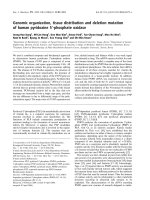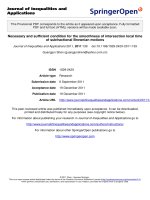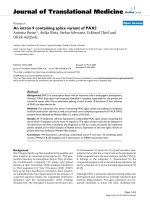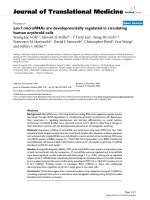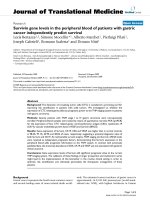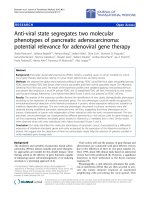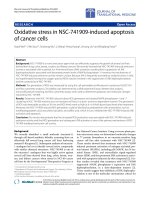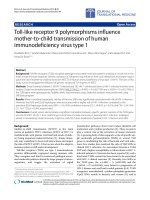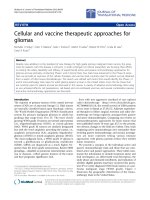Báo cáo hóa học: " Toll-like receptor 9 polymorphisms influence mother-to-child transmission of human immunodeficiency virus type 1" pptx
Bạn đang xem bản rút gọn của tài liệu. Xem và tải ngay bản đầy đủ của tài liệu tại đây (434.67 KB, 5 trang )
Ricci et al. Journal of Translational Medicine 2010, 8:49
/>Open Access
RESEARCH
© 2010 Ricci et al; licensee BioMed Central Ltd. This is an Open Access article distributed under the terms of the Creative Commons At-
tribution License ( which permits unrestricted use, distribution, and reproduction in any
medium, provided the original work is properly cited.
Research
Toll-like receptor 9 polymorphisms influence
mother-to-child transmission of human
immunodeficiency virus type 1
Elisabetta Ricci
1
, Sandro Malacrida
2
, Marisa Zanchetta
3
, Ilaria Mosconi
1
, Marco Montagna
3
, Carlo Giaquinto
4
and
Anita De Rossi*
1,3
Abstract
Background: Toll-like receptors (TLRs) recognize pathogen-associated molecular patterns and play a crucial role in the
host's innate immune response. Genetic variations in TLR genes may influence host-viral interactions and might impact
upon the risk of mother-to-child transmission (MTCT) of Human Immunodeficiency Virus type 1 (HIV-1). The aim of this
study was to investigate the influence of genetic variants of TLR 9 gene on MTCT.
Methods: Three hundred children (118 HIV-1-infected and 182 HIV-1-uninfected) born to HIV-1-infected mothers were
studied. Single nucleotide polymorphisms (SNPs) NM_017442.2
: c.4-44G > A (rs352139) and c.1635A > G (rs352140) of
the TLR9 gene were genotyped by TaqMan allelic discrimination assay. Statistical analyses were performed using
SNPStats program.
Results: When considered separately, neither of the two SNPs was significantly associated with risk of HIV-1 infection.
However, the [A;A] and [G;G] haplotypes were associated with a higher risk of HIV-1 infection compared to the
prevalent [G;A] haplotype [odds ratio (OR) = 3.16, 95% confidence interval (CI) 1.24-8.03, p = 0.016, and OR = 5.54, 95%
CI 1.76-17.50, p = 0.004, respectively].
Conclusions: Overall, results demonstrate a significant correlation between specific genetic variants of the TLR9 gene
and risk of MTCT of HIV-1, thus confirming a critical role of innate immunity in perinatal HIV-1 infection. Strategies
aimed at modulating innate immunity might be useful for future treatment of pediatric HIV-1 infection and AIDS.
Background
Mother-to-child transmission (MTCT) is the main
source of pediatric HIV-1 infection. MTCT of HIV-1 is
multifactorial, with plasma viral load and mode of deliv-
ery being important maternal factors [1]. Innate immu-
nity may contribute to host-viral interactions and impact
the risk of MTCT of HIV-1 that occurs when the adaptive
immune system is still under development.
Toll-like receptors (TLRs) are type 1 transmembrane
proteins differentially expressed among immune cells.
They recognize and bind to conserved pathogen-associ-
ated molecular patterns shared by large groups of micro-
organisms, and trigger the activation of signal
transduction pathways, that in turn induce dendritic cell
maturation and cytokine production [2]. These receptors
play a central role in the activation of innate immunity
[3]. A growing body of data supports a role of specific sin-
gle nucleotide polymorphisms (SNPs) in several TLR
genes in modulating the risk of bacterial and viral infec-
tions. Few studies have analyzed the role of TLR SNPs in
clinical HIV-1 infection. An association between a TLR4
SNP and a higher susceptibility to tuberculosis in HIV-1-
infected patients in Tanzania has been reported [4], and a
functional TLR8 variant has been found to be associated
with HIV-1 clinical outcome [5]. Recently, two SNPs in
the TLR9 gene, the c.4-44G > A (rs352139) and the
c.1635A > G (rs352140), were linked to progression of
HIV-1 disease and viral load in adult patients [6-8]. TLR9
recognizes unmethylated cytidine-phosphate-guanosine
(CpG) DNA motifs in bacteria and viruses [9], and is
* Correspondence:
1
Department of Oncology and Surgical Sciences, Oncology Section, AIDS
Reference Center, University of Padova, Via Gattamelata 64, 35128 Padova, Italy
Full list of author information is available at the end of the article
Ricci et al. Journal of Translational Medicine 2010, 8:49
/>Page 2 of 5
expressed in a wide variety of human cells, including plas-
macytoid dendritic cells.
To date, the relationship between TLR gene polymor-
phisms and perinatal HIV-1 infection has not been inves-
tigated. The present study focuses on the role of c.4-44G
> A and c.1635A > G SNPs in the TLR9 gene in MTCT of
HIV-1 by analyzing a large cohort of HIV-1-infected and
HIV-1-uninfected infants, all born to HIV-1-infected
mothers.
Methods
Patients
The study population included 300 children born to HIV-
1-seropositive mothers between 1984 and 1996, whose
virological analyses for diagnosis of HIV-1 infection were
conducted at the AIDS Reference Center of Padova Uni-
versity. Inclusion criteria were the known HIV-1-sero-
positive status of the mother at delivery, the absence of
antiretroviral prophylaxis during gestation and/or at
delivery, and ethnicity. All children were white Caucasian;
282 (94%) were born by vaginal delivery and 18 by caesar-
ean section, and none was breastfeed. Diagnosis of HIV-1
infection was performed by virus isolation and poly-
merase chain reaction (PCR) [10]. For all children
included in this study, 118 HIV-1-infected and 182 HIV-
1-uninfected, the infection was confirmed by disease
onset and/or persistence of HIV-1 antibody after 18
months of age, while lack of infection was confirmed by
the loss of HIV-1 antibodies. The study was performed in
accordance with the Helsinki Declaration and was
approved by the Ethics Committee of the Azienda
Ospedaliera di Padova. An informed consent regarding
the use of biological specimens for research purposes was
obtained from parents or legal guardians.
SNP Analysis
Genomic DNA was extracted from peripheral blood
mononuclear cells with the QIAamp DNA Blood mini kit
(Qiagen, Hilden, Germany), according to the manufac-
turer's instructions. Polymorphic sites in genomic DNA
were analyzed by TaqMan allelic discrimination assay.
Primers and probes for NM_017442.2
: c.4-44G > A
(rs352139) and c.1635A > G (rs352140) genotyping were
designed with Primer Express software (version 3.0,
Applied Biosystems) (GeneBank reference sequence
NM_017442.2
). The primers were: 5'-CAGGTAGGGCT-
TGGAGAGAGG-3' and 5'-TGGGAGGGCTGTGT-
GAGTG-3' for c.4-44G > A and 5'-TGGACCTCTA
CCACGAGCACT-3' and 5'-AAAGGGCTGGCTGTTG-
TAGCT-3' for c.1635A > G. The TaqMan MGB allele-
specific probes were: FAM-5' TGGAGGTG
GAGCTG-3'-
MGB and VIC-5'-TGGGTGGAGGTA
GAG-3'-MGB for
c.4-44G > A, FAM-5'-ACGGAGCTACCG
CGA-3'-MGB
and VIC-5'-CGGAGCTACCA
CGAC-3'-MGB for
c.1635A > G. PCR was performed in the ABI PRISM 7700
thermal cycler (Applied Biosystems) according to stan-
dard procedures. Thermal cycling conditions were 2 min-
utes at 50°C, 10 minutes at 95°C, and 45 cycles each of
95°C for 15 seconds and 62°C for 1 minute. The geno-
types were assigned using the Sequence Detection Sys-
tem software (version 1.9, Applied Biosystems), analyzing
the threshold cycle of amplification curves. Accuracy of
genotyping was confirmed by direct sequencing of ran-
domly selected samples, as previously described [11],
using the same primers used in Taqman assay.
Quantification of HIV-1 RNA in plasma
Plasma HIV-1 RNA levels were determined by reverse
transcriptase-PCR (Roche Amplicor Monitor System,
New Jersey, USA) according to the manufacturer's
instructions. The lower limit of detection of this assay
was 50 HIV-1 RNA copies/ml of plasma using the ultra-
sensitive protocol.
Statistical analysis
Estimation of the power of the study to detect an associa-
tion between SNPs and HIV-1 infection was evaluated
using the genetic power calculator available at http://
pngu.mgh.harvard.edu/~purcell/gpc/. The study had 80%
power to detect significant (p < 0.05) effects with odds
ratio (OR) greater than 2 for the A allele of c.4-44G > A
and G allele of c.1635A > G. Haplotype frequencies were
estimated from genotype frequencies using the Expecta-
tion-Maximization algorithm coded into the SNPStats
program [12]. All the statistical analyses, including the
Hardy-Weinberg equilibrium test, linkage disequilibrium
estimation, as well as the association of SNP genotypes
and haplotypes with HIV-1 infection status, were per-
formed using SNPStats software [12]. To increase the
power of the study, four genetic models (co-dominant,
dominant, recessive, and additive) were considered.
Moreover, the effect of viral load on the association of
SNPs and haplotypes with HIV-1 infection was tested
with multivariate regression analysis, implemented in the
SNPStats program. ORs and 95% confidence intervals
(CI) were calculated for each group compared to the ref-
erence class (homozygous genotype for the prevalent
allele); p values were derived from the Chi-square test.
The Bonferroni correction of the significance level was
applied to account for multiple testing.
Results
To analyze the impact of c.4-44G > A and c.1635A > G
SNPs on HIV-1 perinatal infection, a cohort of HIV-1-
infected (n = 118) and exposed HIV-1-uninfected (n =
182) children was analyzed with different genetic models.
Genotype and allele frequencies for the two SNPs were in
Hardy-Weinberg equilibrium in both groups and were in
Ricci et al. Journal of Translational Medicine 2010, 8:49
/>Page 3 of 5
agreement with frequencies reported in the NCBI data-
base on the Caucasian population. c.4-44GA was the
most frequent genotype in both HIV-1-uninfected and
HIV-1-infected children, while c.1635AG was the most
frequent genotype in HIV-1-uninfected children. c.4-
44GG and c.1635AA genotypes had a higher prevalence
in HIV-1-infected infants. However, the two SNPs
showed no significant association with the risk of HIV-1
infection in the codominant model (Table 1), or in other
genetic models considered (data not shown).
Linkage disequilibrium analysis confirmed a strong dis-
equilibrium level between the two SNPs with D' = 0.87
and r
2
= 0.74. To investigate their combined effect, given
their close proximity, haplotype frequencies were esti-
mated in both groups of children. [G;A] was the most fre-
quent haplotype in both HIV-1-uninfected and HIV-1-
infected children, while the [G;G] and [A;A] haplotypes
had a low frequency, but were more prevalent in HIV-1-
infected infants, leading to a significantly increased risk
of MTCT of HIV-1 compared to the most frequent [G;A]
and [A;G] haplotypes (Table 1).
Values of maternal viral load at delivery were available
in a subgroup of 109 infants (median 8790 HIV-1 RNA
copies/ml of plasma, range 40-2106650 HIV-1 RNA cop-
ies/ml of plasma). Analyses of allele and genotype fre-
quencies and the Hardy-Weinberg equilibrium in this
subgroup were in agreement with those in the entire
cohort (data not shown). For prevention of MTCT of
HIV-1, highly active antiretroviral therapy was recently
recommended for all women with HIV-1 RNA levels of ≥
1000 copies/ml of plasma [13]. A further analysis was
thus performed categorizing mothers according to low (<
1000 HIV-1 RNA copies/ml of plasma) and high (> 1000
HIV-1 RNA copies/ml of plasma) viral load. As for the
larger cohort, while neither of the two SNPs was signifi-
cantly associated with a risk of HIV-1 infection, the [G;G]
haplotype remained associated with a higher risk of
MTCT of HIV-1 after adjustment for maternal viral load
(OR = 10.04, 95% CI 1.70-59.37, p = 0.012; p = 0.017 sig-
nificance level after Bonferroni correction).
Discussion
TLRs play a central role in innate immunity and a num-
ber of genetic association studies suggest that some TLR
polymorphisms may be associated with susceptibility to
different diseases. There is convincing evidence that
common TLR SNPs modulate immune function by modi-
fying the control of inflammatory cascades, elaboration
of effector molecules, pathogen killing, and interactions
with the adaptive immune response [14]. TLR9 plays a
pivotal role in the induction of first-line defense mecha-
nisms of the innate immune system and triggers effective
adaptive immune responses to different bacterial and
viral pathogens [15,16]. A few genetic polymorphisms
within the TLR9 gene have been reported to be associ-
ated with a variety of inflammatory and infectious dis-
eases [6-8,17,18].
Table 1: Frequencies of TLR9 genotypes and haplotypes and risk of HIV-1 infection.
SNP Genotypes Uninfected
children
(n = 182)
Infected
children
(n = 118)
OR 95% CI p
LCL UCL
c.4-44G > A(rs352139) GG 0.29 0.36 1 0.48
GA 0.50 0.44 0.72 0.42 1.22
AA 0.31 0.20 0.80 0.42 1.53
c.1635A > G(rs352140) AA 0.31 0.39 1 0.20
AG 0.48 0.38 0.62 0.37 1.06
GG 0.21 0.23 0.86 0.46 1.62
Haplotypes G;A 0.53 0.51 1
A;G 0.44 0.36 0.92 0.65 1.30 0.63*
A;A 0.02 0.07 3.16 1.24 8.03 0.016*
G;G 0.01 0.06 5.54 1.76 17.50 0.0038*
LCL, lower confidence limit; UCL, upper confidence limit.
* The significance level after Bonferroni correction for multiple testing is 0.017 instead of 0.05.
Ricci et al. Journal of Translational Medicine 2010, 8:49
/>Page 4 of 5
Our study investigates for the first time the relationship
between c.4-44G > A and c.1635A > G SNPs of TLR9 and
MTCT of HIV-1, revealing that the TLR9 [A;A] and
[G;G] haplotypes are associated with a significantly
increased risk of MTCT of HIV-1. Genetic variations of
TLR9, as a key gene of innate immunity, could impact on
immunological downstream responses that are critically
important for host defenses. The function of these SNPs
and haplotypes is still largely unknown. Neither of the
two SNPs induces amino acid change, but several find-
ings suggest that they may affect TLR9 expression
[7,8,17]. Functional studies demonstrated a critical role
for the G allele of the c.4-44G > A SNP on TLR9 expres-
sion [17], and the c.4-44GG genotype was found to be
associated with slow disease progression in HIV-1
infected adults [6]. The c.1635A > G SNP was also found
to influence the progression of HIV-1 disease [6-8]. Fur-
thermore, association of the c.1635A > G with CD4 cell
count and viral load has suggested a role of this SNP in
TLR9-mediated immune activation [7,8]. It has been
demonstrated that sooty mangabeys have reduced levels
of innate immune activation during apathogenic simian
immunodeficiency virus infection and that plasmocytoid
dendritic cells from these animals produce markedly low
levels of interferon α in response to TLR9 ligands [19].
Specific haplotypes in the TLR9 gene might influence the
functional ability of TLR9 to elicit a defense mechanism
by affecting susceptibility or resistance to infections.
Conclusions
In conclusion, our results demonstrate an important role
of genetic variants of the TLR9 gene in modulating the
risk of MTCT of HIV-1, thus confirming the relevance of
innate immunity in perinatal HIV-1 infection. This
knowledge may be valuable in the development of new
therapeutic strategies including the use the specific adju-
vants. More studies are needed to evaluate if strategies
aimed at modulating innate immunity might be useful for
future treatment of pediatric HIV-1 infection and AIDS.
List of abbreviations
CI: confidence intervals; HIV-1: Human Immunodefi-
ciency Virus type 1; MTCT: mother-to-child transmis-
sion; OR: odds ratio; SNP: single nucleotide
polymorphism; TLR: Toll-like receptor.
Competing interests
The authors declare that they have no competing interests.
Authors' contributions
ER planned the study, performed genotyping and drafted the manuscript. SM
performed statistical calculations and drafted the manuscript. IM contributed
to genotyping and drafted the manuscript. MM contributed to statistical calcu-
lations and drafted the manuscript. MZ contributed to patient inclusion and
handled samples collection and storage until nucleic acid extraction. CG
recruited patients, collected clinical data, and contributed to study design. ADR
planned and coordinated the study, supervised genotyping and statistical cal-
culations, and drafted the manuscript. All authors read and approved the final
manuscript.
Acknowledgements
We acknowledge Lisa Smith for help in the writing of the manuscript. This work
was supported by Istituto Superiore di Sanità, Progetto AIDS Grant no. 45F.13
and no. 45G.12 and PENTA foundation. ER was supported by PENTA Founda-
tion.
Author Details
1
Department of Oncology and Surgical Sciences, Oncology Section, AIDS
Reference Center, University of Padova, Via Gattamelata 64, 35128 Padova, Italy
,
2
Department of Neurosciences, University of Padova, Via Giustiniani 5, 35128
Padova, Italy,
3
Istituto Oncologico Veneto-IRCCS, Padova, Via Gattamelata 64,
35128 Padova, Italy and
4
Department of Pediatrics, University of Padova, Via
Giustiniani 3, 35128 Padova, Italy
References
1. The European Collaborative Study:: Maternal viral load and vertical
transmission of HIV-1: an important factor but not the only one. AIDS
1999, 13:1377-1385.
2. Akira S, Uematsu S, Takeuchi O: Pathogen recognition and innate
immunity. Cell 2006, 124:783-801.
3. Uematsu S, Akira S: Toll-like receptors and innate immunity. J Mol Med
2006, 84:712-725.
4. Ferwerda B, Kibiki GS, Netea MG, Dolmans WM, van der Ven AJ van der:
The toll-like receptor 4 Asp299Gly variant and tuberculosis
susceptibility in HIV-infected patients in Tanzania. AIDS 2007,
21:1375-1377.
5. Oh DY, Taube S, Hamouda O, Kücherer C, Poggensee G, Jessen H, Eckert
JK, Neumann K, Storek A, Pouliot M, Borgeat P, Oh N, Schreier E, Pruss A,
Hattermann K, Schumann RR: A functional toll-like receptor 8 variant is
associated with HIV disease restriction. J Infect Dis 2008, 198:701-709.
6. Bochud PY, Hersberger M, Taffé P, Bochud M, Stein CM, Rodrigues SD,
Calandra T, Francioli P, Telenti A, Speck RF, Aderem A, Swiss HIV Cohort
Study: Polymorphisms in Toll-like receptor 9 influence the clinical
course of HIV-1 infection. AIDS 2007, 21:441-446.
7. Soriano-Sarabia N, Vallejo A, Ramírez-Lorca R, Rodríguez Mdel M, Salinas A,
Pulido I, Sáez ME, Leal M: Influence of the Toll-like receptor 9 1635A/G
polymorphism on CD4 count, HIV viral load, and clinical progression. J
Acquir Immune Defic Syndr 2008, 49:128-135.
8. Pine SO, McElrath MJ, Bochud PY: Polymorphisms in toll-like receptor 4
and toll-like receptor 9 influence viral load in a seroincident cohort of
HIV-1-infected individuals. AIDS 2009, 27:2387-95.
9. Barton GM, Kagan JC, Medzhitov R: Intracellular localization of Toll-like
receptor 9 prevents recognition of self DNA but facilitates access to
viral DNA. Nat Immunol 2006, 7:49-56.
10. De Rossi A, Ades AE, Mammano F, Del Mistro A, Amadori A, Giaquinto C,
Chieco-Bianchi L: Antigen detection, virus culture, polymerase chain
reaction, and in vitro antibody production in the diagnosis of vertically
transmitted HIV-1 infection. AIDS 1991, 5:15-20.
11. Ricci E, Malacrida S, Zanchetta M, Montagna M, Giaquinto C, De Rossi A:
Role of β-Defensin-1 polymorphisms in mother-to-child transmission
of Human Immunodeficiency Virus Type 1. J Acquir Immune Defic Syndr
2009, 51:13-19.
12. Solé X, Guinó E, Valls J, Iniesta R, Moreno : SNPStats: a web tool for the
analysis of association studies. Bioinformatics 2006, 22:1928-1929.
13. Jamieson DJ, Clark J, Kourtis AP, Taylor AW, Lampe MA, Fowler MG,
Mofenson LM: Recommendations for human immunodeficiency virus
screening, prophylaxis, and treatment for pregnant women in the
United States. Am J Obstet Gynecol 2007, 197:S26-32.
14. Bowie AG, Haga IR: The role of Toll-like receptors in the host response to
viruses. Mol Immunol 2005, 42:859-867.
15. Müller T, Hamm S, Bauer S: TLR9-mediated recognition of DNA. Handb
Exp Pharmacol 2008, 183:51-70.
16. Carpenter EL, Mick R, Rüter J, Vonderheide RH: Activation of human B
cells by the agonist CD40 antibody CP-870,893 and augmentation with
simultaneous toll-like receptor 9 stimulation. J Transl Med 2009, 7:93.
Received: 11 January 2010 Accepted: 25 May 2010
Published: 25 May 2010
This article is available from: 2010 Ricci et al; licensee BioMed Central Ltd. This is an Open Access article distributed under the terms of the Creative Commons Attribution License ( which permits unrestricted use, distribution, and reproduction in any medium, provided the original work is properly cited.Journal of Tr anslational Medi cine 2010, 8:49
Ricci et al. Journal of Translational Medicine 2010, 8:49
/>Page 5 of 5
17. Tao K, Fujii M, Tsukumo S, Maekawa Y, Kishihara K, Kimoto Y, Horiuchi T,
Hisaeda H, Akira S, Kagami S, Yasutomo K: Genetic variations of Toll-like
receptor 9 predispose to systemic lupus erythematosus in Japanese
population. Ann Rheum Dis 2007, 66:905-909.
18. Leoratti FM, Farias L, Alves FP: Variants in the toll-like receptor signaling
pathway and clinical outcomes of malaria. J Infect Dis 2008,
198:772-780.
19. Mandl JN, Barry AP, Vanderford TH, Kozyr N, Chavan R, Klucking S, Barrat
FJ, Coffman RL, Staprans SI, Feinberg MB: Divergent TLR7 and TLR9
signaling and type I interferon production distinguish pathogenic and
nonpathogenic AIDS virus infections. Nat Med 2008, 14:1077-1087.
doi: 10.1186/1479-5876-8-49
Cite this article as: Ricci et al., Toll-like receptor 9 polymorphisms influence
mother-to-child transmission of human immunodeficiency virus type 1 Jour-
nal of Translational Medicine 2010, 8:49
